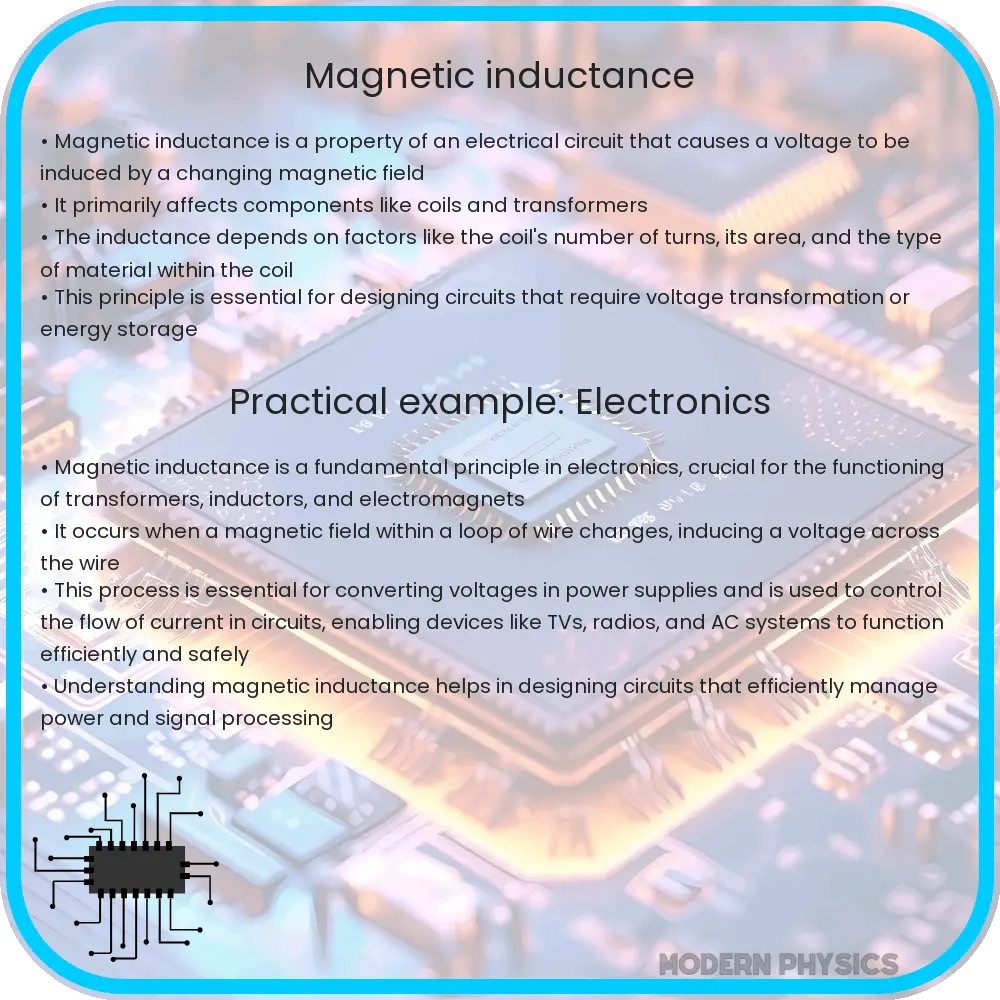Explore magnetic inductance: its principles, applications in technology and power systems, challenges, innovations, and environmental impact.

Magnetic Inductance: Understanding the Core Concepts
Magnetic inductance, a fundamental principle in electromagnetism, plays a crucial role in modern electrical engineering and technology. It refers to the property of an electrical conductor by which a change in current flowing through it induces an electromotive force (EMF) in both the conductor itself (self-inductance) and in any nearby conductors (mutual inductance). This concept is vital for understanding how transformers, inductors, and various types of electrical circuits function.
Principles of Magnetic Inductance
The phenomenon of magnetic inductance is primarily governed by Faraday’s Law of Electromagnetic Induction, which states that any change in the magnetic environment of a coil of wire will cause a voltage (EMF) to be induced in the coil. Mathematically, this is expressed as EMF = -N(dΦB/dt), where N is the number of turns in the coil, and ΦB is the magnetic flux. The negative sign indicates Lenz’s Law, signifying that the induced EMF always opposes the change in flux that produced it.
Applications of Magnetic Inductance
Magnetic inductance finds its application in various areas:
- Transformers: They operate on the principle of mutual inductance to transfer electrical energy between circuits, efficiently changing voltages in power systems.
- Inductors: These components, found in electronic circuits, utilize self-inductance to store energy in a magnetic field when electric current flows through them.
- Electromagnetic Interference (EMI) Mitigation: Inductance is used in filters to suppress unwanted electrical noise in electronic systems.
Analysis and Mathematical Interpretation
The behavior of inductive components in circuits can be mathematically analyzed using the concept of inductive reactance, which is the opposition that an inductor presents to alternating current, due to the inductance. Inductive reactance (XL) is given by XL = 2πfL, where f is the frequency of the alternating current and L is the inductance. This formula helps in designing circuits with desired properties and in understanding the behavior of existing circuits under various conditions.
Understanding magnetic inductance is essential for the development and improvement of a wide range of electrical devices and systems. From everyday household appliances to complex industrial machinery, the principles of magnetic inductance are at work, making it a cornerstone of modern electrical engineering.
Deeper Insights into Magnetic Inductance
Further exploration into magnetic inductance reveals its critical role in modern technology. One of the intriguing aspects is the creation of superconducting magnets, which utilize materials that offer zero resistance at extremely low temperatures. These superconductors can carry large currents, creating strong magnetic fields without the energy loss typically associated with resistance in conventional conductors. This technology is pivotal in medical imaging techniques like MRI and in large-scale scientific instruments such as particle accelerators.
Challenges and Innovations in Inductance Technology
Despite its widespread applications, the concept of magnetic inductance presents certain challenges. For instance, in power systems, inductance can lead to inefficiencies due to energy being stored and released in the magnetic field, known as reactive power. Engineers and scientists continuously work on optimizing inductance in electrical systems to minimize energy loss and improve efficiency. Recent advancements include the development of high-permeability materials for inductors and transformers, which enhance the efficiency of magnetic flux linkage and reduce energy losses.
Environmental Impact and Sustainability
The role of magnetic inductance in environmental sustainability is also noteworthy. Efficient transformers and inductors contribute significantly to reducing energy consumption in electrical systems. Moreover, the development of efficient inductive components is crucial in renewable energy systems, such as wind turbines and solar inverters, promoting the adoption of clean and sustainable energy sources.
Conclusion
Magnetic inductance, a fundamental principle in electromagnetism, has profound implications across various fields of science and engineering. Its applications, ranging from everyday electrical appliances to sophisticated scientific instruments, underscore its significance in the modern technological landscape. While it presents certain challenges in terms of efficiency and energy loss, ongoing innovations continue to harness its potential more effectively. The integration of inductance-based technologies in renewable energy systems also highlights its role in promoting environmental sustainability. As research and development in this field advance, magnetic inductance will undoubtedly continue to be a key driver of innovation and efficiency in the world of electrical engineering.
